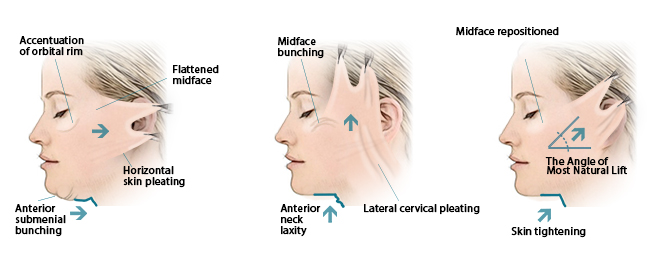
Has aging had you considering a facelift recently? You’re not alone. Every year, thousands of facelifts are performed on patients of all ages. Moreover, nowadays, as facial plastic surgeons grow more and more specialized and innovative, there are numerous types of facelifts to choose from.
Two of the most popular options for facial procedures are those that reduce the appearance of having work done: the SMAS facelift and the deep plane facelift.
In this article, we’ll explore these procedures in more detail, for the benefit of interested readers, to help them decide which is right for them.
SMAS Facelift
As your facial skin ages, there is lost laxity in the epidermis and well as the superficial musculoaponeurotic system (SMAS) membrane. This loss brings about hanging cheeks along the jaw bone, producing the ever feared “twofold jawline.” Cheek fat will at that point hang forward to build the presence of the nasolabial folds.
The SMAS facelift neutralizes the indications of maturing by fixing the muscle, expelling fat, and cutting abundance skin. The SMAS is a layer of tissue deep inside the skin and subcutaneous tissue
The SMAS technique uses a smaller than normal, ‘short scar facelift’, or s-type entry point, making a pigtail cosmetic touch up that shrouds the cut behind the ears around within the little rectangular "tragus" at the opening of the ears, and end behind the ear cartilage and back of the ear.
What Does a SMAS Facelift Improve?
A SMAS facelift is successful in amending the accompanying:
-Hollowing cheeks
-Nasolabial folds
-Sagging Jowls
-Loose skin and fat under the jaw and facial structure
-Listing fat
Sometimes referred to as a ‘mini-facelift’, the procedure tends to the lower third of the face and facial structure. Accordingly, numerous specialists prescribe taking fat from the belly or thighs and infusing it into the face (fat uniting) notwithstanding SMAS medical procedure.
Often, it is believed that volume loss is the central explanation behind the hollowing and shadows that accompany maturing; this is not always the case. Viewing pre-and post-procedural photographs of patients, it is apparent that gravity is usually to blame.
SMAS Facelift Recuperation
It can take as long as a month to completely recuperate. With results long haul results that can keep going for 10+ years, many consider a SMAS facelift a beneficial venture. Likewise, with any medical procedure, the strategy carries a few risks — something you should speak about with your surgeon.
What is a Deep Plane Facelift?
A conventional facelift centers around molding the facial structure and fixing the neck. The real distinction is that a deep plane methodology repositions the tissues instead of destroying them, prompting an increasingly common outcome. Also, a deep plane facelift will improve the midface territory. The external corner of the forehead may likewise be lifted with a deep plane facelift.
Deep Plane Facelift Complications
The dangers, while uncommon, are the equivalent regardless of what kind of facelift you have had: contamination, dying, swelling, wounding, facial nerve harm, and facial asymmetry. On the off chance that you presume any confusion during your recuperating procedure, alert your facial plastic specialist as quickly as time permits. While these intricacies don't happen frequently, they may happen, so they ought not to be overlooked.
Do Deep Plane Facelifts Leave Scars?
In a perfect world, facelift scars are imperceptible once completely healed. Cuts are made along the hairline. This enables the surgeon to lift and reposition the facial muscles and upper fatty tissue layers in the territory of the cheekbone and mid-face. A similar cut is then expanded descending, utilizing the common wrinkles in the skin in front and behind the ear, just as behind the ear cartilage.
Results are subtler, enabling more youthful patients to fight off the impacts of maturing right off the bat, as opposed to holding on to address genuine defects after they have happened. This facelift can at present be performed on a more seasoned patient who is looking for increasingly emotional outcomes that can offer a revived and restored regular appearance, as opposed to the tight, "pulled" look one gets with the SMAS facelift.
If deep plane facelifts are considered so preferable, why isn't everyone doing it? The answer: it requires more ability and preparing concerning the facial plastic specialist.
The muscle and sinewy tissue are isolated from the hidden layers of the cheeks, face, and neck. The skin fat and fundamental muscles are left associated and moved as a unit, not isolated as in SMAS fold procedures.
During your deep plane facelift, you will be either calmed in a "twilight sleep" state or under general anesthesia for your solace and wellbeing. The entry points made are like those of a SMAS facelift, reaching out along the hairline and around the ears.
Which Facelift Is Right for You?
Each person is different, and so they can respond better to different kinds of procedures. In a comparative study, test groups were separated by age groups: 50 to 59, 60 to 69, and 70 to 80 years.
SMAS facelifts scored higher than deep plane facelifts in the two younger groups. In the oldest, deep plane facelifts scored marginally higher than SMAS facelifts.
Choosing A Facial Plastic Surgeon
Ultimately, the choice should be made between you and your qualified, board-certified facial plastic surgeon. You should select one is who is a facelift expert, who understands both the complex nature of the face and the unique qualities of your particular face that calls for one type of procedure over another.
Your face is your personal calling card, the most special part of you. You must research well, be aware of what you want and how you hope to appear; you should let the physician know about any concerns you have about recovery, reactions, complications, and expectations. And whether you end up with a SMAS facelift, a deep plane facelift, or perhaps another procedure, satisfaction with the result is always the end goal.

Be the first to comment